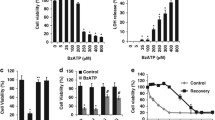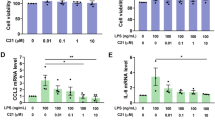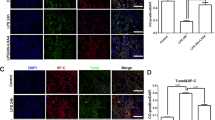Abstract
Acute lung injury (ALI) or acute respiratory distress syndrome (ARDS) are common syndromes characterized by diffuse, acute injury to the alveolar epithelium and pulmonary vascular endothelial cells, with high mortality rate for there are no effective pharmacological therapies. Peroxisome proliferators-activated receptor γ (PPARγ), a member of the nuclear hormone receptor superfamily of ligand-activated transcription factors, is ubiquitously expressed within the lung. Recent studies have indicated PPARγ can protect lung tissue and alleviate pulmonary inflammatory injury. But no studies examined whether PPARγ agonists can protect the alveolar epithelial cells cultured in vitro. We observed the protective effect of PPARγ in LPS-induced alveolar type II epithelial cells injury. The results showed troglitazone-activated PPARγ could inhibit the production of TNF-α, one of the most important inflammatory factors, and then increased the expression of surfactant-associated protein A (SP-A) and attenuate the apoptosis of alveolar type II epithelial cells. Our results suggest that PPARγ may have a potential therapeutic effect on ALI.




Similar content being viewed by others
References
Ware LB (2006) Pathophysiology of acute lung injury and the acute respiratory distress syndrome. Semin Respir Crit Care Med 27:249–337
Zhan J, Liu Y, Zhang Z, Chen C, Chen K, Wang Y (2010) Effect of penehyclidine hydrochloride on expressions of MAPK in mice with CLP-induced acute lung injury. Mol Biol Rep. doi: 10.1007/s11033-010-0310-0
Puneet P, Moochhala S, Bhatia M (2005) Chemokines in acute respiratory distress syndrome. Am J Physiol Lung Cell Mol Physiol 288:L3–L15
Zhang C, Wu X, Zhao Y, Deng Z, Qian G (2010) SIGIRR inhibits toll-like receptor 4, 5, 9-mediated immune responses in human airway epithelial cells. Mol Biol Rep. doi: 10.1007/s11033-010-0146-7
Chen L, Tian G, Shao C, Cobos E, Gao W (2010) Curcumin modulates eukaryotic initiation factors in human lung adenocarcinoma epithelial cells. Mol Biol Rep 37:3105–3110
Bhatia M, Moochhala S, Moochhala S (2004) Role of inflammatory mediators in the pathophysiology of acute respiratory distress syndrome. J Pathol 202:145–156
Griffiths MJ, Bonnet D, Janes SM (2005) Stem cells of the alveolar epithelium. Lancet 366:249–260
Mason RJ (2006) Biology of alveolar type II cells. Respirology 11(Suppl):S12–S15
Issemann I, Green S (1990) Activation of a member of the steroid hormone receptor superfamily by peroxisome proliferators. Nature 347:645–650
Kota BP, Huang TH, Roufogalis BD (2005) An overview on biological mechanisms of PPARs. Pharmacol Res 51:85–94
Zhao Y, Yang G, Ren D, Zhang X, Yin Q, Sun X (2010) Luteolin suppresses growth and migration of human lung cancer cells. Mol Biol Rep. doi: 10.1007/s11033-010-0208-x
Heikkinen S, Auwerx J, Argmann CA (2007) PPAR gamma in human and mouse physiology. Biochim Biophys Acta 1771:999–1013
Zieleniak A, Wójcik M, Woźniak LA (2008) Structure and physiological functions of the human peroxisome proliferator-activated receptor gamma. Arch Immunol Ther Exp (Warsz) 56:331–345
Chinetti G, Griglio S, Antonucci M, Torra IP, Delerive P, Majd Z, Fruchart JC, Chapman J, Najib J, Staels B (1998) Activation of proliferator-activated receptors α and γ induces apoptosis of human monocyte-derived macrophages. J Biol Chem 273:25573–25580
Ricote M, Huang J, Fajas L, Li A, Welch J, Najib J, Witztum JL, Auwerx J, Palinski W, Glass CK (1998) Expression of the peroxisome proliferator-activated receptor γ (PPARγ) in human atherosclerosis and regulation in macrophages by colony stimulating factors and oxidized low density lipoprotein. Proc Natl Acad Sci USA 95:7614–7619
Standiford TJ, Keshamouni VG, Reddy RC (2005) Peroxisome proliferator-activated receptor-γ as a regulator of lung inflammation and repair. Proc Am Thorac Soc 2:226–231
Hong L, Sun H, Lv X, Yang D, Zhang J, Shi Y (2009) Expression of periostin in the serum of NSCLC and its function on proliferation and migration of human lung adenocarcinoma cell line (A549) in vitro. Mol Biol Rep 37:2285–2293
Cui J, Meng X, Gao X, Tan G (2009) Curcumin decreases the expression of Pokemon by suppressing the binding activity of the Sp1 protein in human lung cancer cells. Mol Biol Rep 37:1627–1632
Wang ACC, Dai X, Luu B, Conrad DJ (2001) Peroxisome proliferator-activated receptor-γ regulates airway epithelial cell activation. Am J Respir Cell Mol Biol 24:688–693
Arnold R, König W (2006) Peroxisome-proliferator-activated receptor-γ agonists inhibit the release of proinflammatory cytokines from RSV-infected epithelial cells. Virology 346:427–439
Liu H, Zhang T, Wu B, Huang J, Zhou Y, Zhu J (2009) Chronic exposure to exogenous matrilysin induces chemoresistance and enhances Bcl-2 expression in A549 lung adenocarcinoma cells. Mol Biol Rep 36:2099–2109
Hetzel M, Walcher D, Grüb M, Bach H, Hombach V, Marx N (2003) Inhibition of MMP-9 expression by PPARγ activators in human bronchial epithelial cells. Thorax 58:778–783
Ciura J, Jagodziński PP (2010) Butyrate increases the formation of anti-angiogenic vascular endothelial growth factor variants in human lung microvascular endothelial cells. Mol Biol Rep 37:3729–3734
Patel HJ, Belvisi MG, Bishop-Bailey D, Yacoub MH, Mitchell JA (2003) Activation of peroxisome proliferator-activated receptors in human airway smooth muscle cells has a superior anti-inflammatory profile to corticosteroids: relevance for chronic obstructive pulmonary disease therapy. J Immunol 170:2663–2669
Cuzzocrea S, Pisano B, Dugo L, Ianaro A, Maffia P, Patel NS, Di Paola R, Ialenti A, Genovese T, Chatterjee PK, Di Rosa M, Caputi AP, Thiemermann C (2004) Rosiglitazone, a ligand of the peroxisome proliferator-activated receptor-gamma, reduces acute inflammation. Eur J Pharmacol 483:79–93
Liu D, Zeng BX, Zhang SH, Wang YL, Zeng L, Geng ZL, Zhang SF (2005) Rosiglitazone, a peroxisome proliferator-activated receptor-gamma agonist, reduces acute lung injury in endotoxemic rats. Crit Care Med 33:2309–2316
Chima RS, Hake PW, Piraino G, Mangeshkar P, Denenberg A, Zingarelli B (2008) Ciglitazone ameliorates lung inflammation by modulating the inhibitor kappaB protein kinase/nuclear factor-kappaB pathway after hemorrhagic shock. Crit Care Med 36:2849–2857
Dobbs LG (1990) Isolation and culture of alveolar type II cells. Am J Physiol 258:134–147
Walker SR, Hale S, Malkinson AM, Mason RJ (1989) Properties of isolated nonciliated bronchiolar cells from mouse lung. Lung Res 15:553–573
Liu D, Zeng BX, Shang Y (2006) Decreased expression of peroxisome proliferator-activated receptor gamma in endotoxin-induced acute lung injury. Physiol Res 55:291–299
Lin YZ, Yao SY, Veach RA, Torgerson TR, Hawiger J (1995) Inhibition of nuclear translocation of transcription factor NF-kappa B by a synthetic peptide containing a cell membrane-permeable motif and nuclear localization sequence. J Biol Chem 24:14255–14258
Dai Y, Pei XY, Rahmani M, Conrad DH, Dent P, Grant S (2004) Interruption of the NF-kappaB pathway by Bay 11–7082 promotes UCN-01-mediated mitochondrial dysfunction and apoptosis in human multiple myeloma cells. Blood 7:2761–2770
Cho DH, Choi YJ, Jo SA, Ryou J, Kim JY, Chung J, Jo I (2006) Troglitazone acutely inhibits protein synthesis in endothelial cells via a novel mechanism involving protein phosphatase 2A-dependent p70 S6 kinase inhibition. Am J Physiol Cell Physiol 2:C317–C326
Chaffer CL, Thomas DM, Thompson EW, Williams ED (2006) PPAR gamma-independent induction of growth arrest and apoptosis in prostate and bladder carcinoma. BMC Cancer 6:53
Fröhlich E, Machicao F, Wahl R (2005) Action of thiazolidinediones on differentiation, proliferation and apoptosis of normal and transformed thyrocytes in culture. Endocr Relat Cancer 2:291–303
Zongze Z, Jia Z, Chang C, Kai C, Yanlin W (2010) Protective effects of remifentanil on septic mice. Mol Biol Rep 37:2803–2808
Zingarelli B, Sheehan M, Wong HR (2003) Nuclear factor-κB as a therapeutic target in critical care medicine. Crit Care Med 31(Suppl):S105–S111
Basak S, Hoffmann A (2008) Crosstalk via the NF-kappaB signaling system. Cytokine Growth Factor Rev 19:187–197
Mukhopadhyay S, Hoidal JR, Mukherjee TK (2006) Role of TNFalpha in pulmonary pathophysiology. Respir Res 7:125
Cirelli RA, Carey LA, Fisher JK, Rosolia DL, Elsasser TH, Caperna TJ, Gee MH, Albertine KH (1995) Endotoxin infusion in anesthetized sheep is associated with intrapulmonary sequestration of leukocytes that immunohistochemically express tumor necrosis factor-alpha. J Leukoc Biol 57:820–826
Xing Z, Kirpalani H, Torry D, Jordana M, Gauldie J (1993) Polymorphonuclear leukocytes as a significant source of tumor necrosis factor-alpha in endotoxin-challenged lung tissue. Am J Pathol 143:1009–1015
Fehrenbach H (2001) Alveolar epithelial type II cell: defender of the alveolus revisited. Respir Res 2:33–46
Posadas-Calleja JG, Ugarte-Torres A (2003) Alveolar epithelial barrier in patients with acute respiratory distress syndrome (ARDS). Rev Invest Clin 55:465–470
Dechert RE (2003) The pathophysiology of acute respiratory distress syndrome. Respir Care Clin N Am 9:283–296
Sugahara K, Tokumine J, Teruya K, Oshiro T (2006) Alveolar epithelial cells: differentiation and lung injury. Respirology 11(Suppl):S28–S31
Geiser T (2003) Mechanisms of alveolar epithelial repair in acute lung injury—a translational approach. Swiss Med Wkly 133:586–590
Hastings RH (2000) Monitoring alveolar epithelial function in acute lung injury. J Clin Monit Comput 16:385–392
Greene KE, Wright JR, Steinberg KP, Ruzinski JT, Caldwell E, Wong WB, Hull W, Whitsett JA, Akino T, Kuroki Y, Nagae H, Hudson LD, Martin TR (1999) Serial changes in surfactant-associated proteins in lung and serum before and after onset of ARDS. Am J Respir Crit Care Med 160:1843–1850
Miakotina OL, Snyder JM (2002) TNF-alpha inhibits SP-A gene expression in lung epithelial cells via p38 MAPK. Am J Physiol Lung Cell Mol Physiol 283:418–427
Michael LF, Lazar MA, Mendelson CR (1997) Peroxisome proliferator-activated receptor gamma1 expression is induced during cyclic adenosine monophosphate-stimulated differentiation of alveolar type II pneumonocytes. Endocrinology 138:3695–3703
Ma X, Xu D, Ai Y, Ming G, Zhao S (2010) Fas inhibition attenuates lipopolysaccharide-induced apoptosis and cytokine release of rat type II alveolar epithelial cells. Mol Biol Rep 37:3051–3056
Lu Q, Harrington EO, Rounds S (2005) Apoptosis and lung injury. Keio J Med 54:184–189
Chen YS, Li HR, Lin M, Chen G, Xie BS, Xu NL, Lin LF (2009) Livin abrogates apoptosis of SPC-A1 cell by regulating JNKI signaling pathway. Mol Biol Rep 37:2241–2247
Tao GH, Yang LQ, Gong CM, Huang HY, Liu JD, Liu JJ, Yuan JH, Chen W, Zhuang ZX (2009) Effect of PARP-1 deficiency on DNA damage and repair in human bronchial epithelial cells exposed to Benzo(a)pyrene. Mol Biol Rep 36:2413–2422
White MK, Baireddy V, Strayer DS (2001) Natural protection from apoptosis by surfactant protein A in type II pneumocytes. Exp Cell Res 263:183–192
Acknowledgments
Sources of Support: National Natural Science Foundation of China (30570808). We thank Fuyun Ji for her help in the experiment.
Author information
Authors and Affiliations
Corresponding author
Rights and permissions
About this article
Cite this article
Xiao, B., Xu, J., Wang, G. et al. Troglitazone-activated PPARγ inhibits LPS-induced lung alveolar type II epithelial cells injuries via TNF-α. Mol Biol Rep 38, 5009–5015 (2011). https://doi.org/10.1007/s11033-010-0647-4
Received:
Accepted:
Published:
Issue Date:
DOI: https://doi.org/10.1007/s11033-010-0647-4




